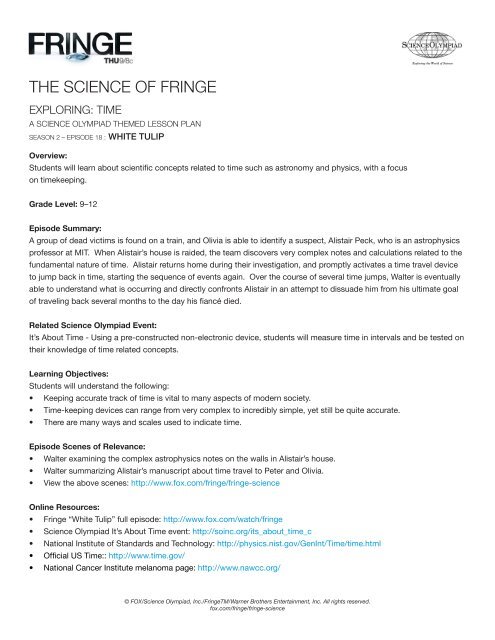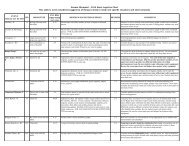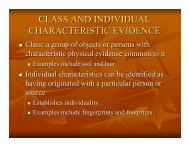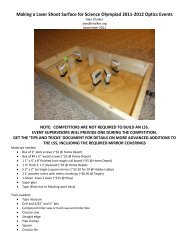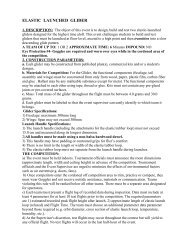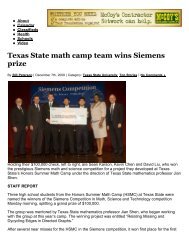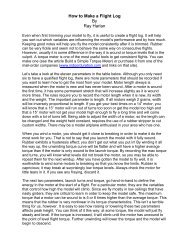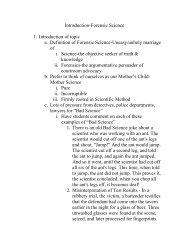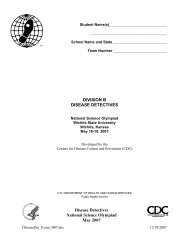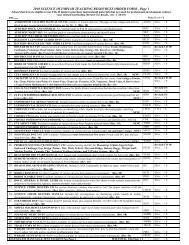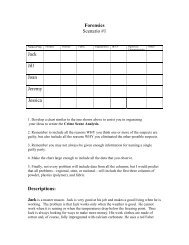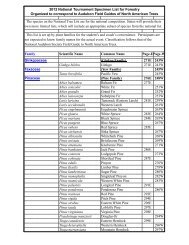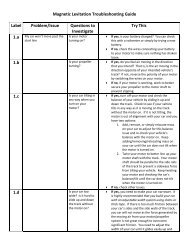THE SCIENCE OF FRINGE - Science Olympiad
THE SCIENCE OF FRINGE - Science Olympiad
THE SCIENCE OF FRINGE - Science Olympiad
You also want an ePaper? Increase the reach of your titles
YUMPU automatically turns print PDFs into web optimized ePapers that Google loves.
<strong>THE</strong> <strong>SCIENCE</strong> <strong>OF</strong> <strong>FRINGE</strong><br />
EXPLORING: TIME<br />
A <strong>SCIENCE</strong> OLYMPIAD <strong>THE</strong>MED LESSON PLAN<br />
SEASON 2 – EPISODE 18 : WHITE TULIP<br />
Overview:<br />
Students will learn about scientific concepts related to time such as astronomy and physics, with a focus<br />
on timekeeping.<br />
Grade Level: 9–12<br />
Episode Summary:<br />
A group of dead victims is found on a train, and Olivia is able to identify a suspect, Alistair Peck, who is an astrophysics<br />
professor at MIT. When Alistair’s house is raided, the team discovers very complex notes and calculations related to the<br />
fundamental nature of time. Alistair returns home during their investigation, and promptly activates a time travel device<br />
to jump back in time, starting the sequence of events again. Over the course of several time jumps, Walter is eventually<br />
able to understand what is occurring and directly confronts Alistair in an attempt to dissuade him from his ultimate goal<br />
of traveling back several months to the day his fiancé died.<br />
Related <strong>Science</strong> <strong>Olympiad</strong> Event:<br />
It’s About Time - Using a pre-constructed non-electronic device, students will measure time in intervals and be tested on<br />
their knowledge of time related concepts.<br />
Learning Objectives:<br />
Students will understand the following:<br />
• Keeping accurate track of time is vital to many aspects of modern society.<br />
• Time-keeping devices can range from very complex to incredibly simple, yet still be quite accurate.<br />
• There are many ways and scales used to indicate time.<br />
Episode Scenes of Relevance:<br />
• Walter examining the complex astrophysics notes on the walls in Alistair’s house.<br />
• Walter summarizing Alistair’s manuscript about time travel to Peter and Olivia.<br />
• View the above scenes: http://www.fox.com/fringe/fringe-science<br />
Online Resources:<br />
• Fringe “White Tulip” full episode: http://www.fox.com/watch/fringe<br />
• <strong>Science</strong> <strong>Olympiad</strong> It’s About Time event: http://soinc.org/its_about_time_c<br />
• National Institute of Standards and Technology: http://physics.nist.gov/GenInt/Time/time.html<br />
• Official US Time:: http://www.time.gov/<br />
• National Cancer Institute melanoma page: http://www.nawcc.org/<br />
© FOX/<strong>Science</strong> <strong>Olympiad</strong>, Inc./FringeTM/Warner Brothers Entertainment, Inc. All rights reserved.<br />
fox.com/fringe/fringe-science
Procedures:<br />
1. Tell your students that they are going to learn about time and time-keeping devices.<br />
2. Have your students research time-related topics in resources such as astronomy and physics textbooks and discuss<br />
what they have learned.<br />
3. Divide your class into groups. Have each group complete the following activity:<br />
a. Materials: several feet of thin string or fishing line, tape, a ruler, stopwatch, large washers or nuts<br />
b. Tape the ruler to the top of a table so that half of it is sticking over the edge.<br />
c. Tie several of the washers or nuts together at the end of the string to serve as a weight.<br />
d. Create a pendulum by taping the end of the string to the ruler such that the washers or nuts can swing freely<br />
2-3 feet below.<br />
e. Use the stopwatch to count how many times the pendulum swings in 15 seconds.<br />
f. Allow the pendulum to continue to swing for 15 seconds and then count how many times it swings in the following<br />
15 seconds.<br />
g. Repeat the process several times, starting the pendulum at varying angles each time.<br />
h. Shorten and/or lengthen the string and note the effect on the period of the pendulum.<br />
i. Add and/or remove weight from the end of the pendulum and note the effect on the period.<br />
j. Try to adjust the pendulum such that its period is exactly one second.<br />
4. Lead the class in a discussion comparing their results. Discuss how only the length of the pendulum impacts its<br />
period. Relate this experiment back to the design of time-keeping devices such as grandfather clocks.<br />
5. Discuss different situations the students regularly encounter where it is important to keep accurate track of time,<br />
such as attending class, cooking, sporting events, and traveling.<br />
Additional Discussion Suggestions:<br />
• There are several other basic time-keeping device designs, such as sand or water clocks, torsional pendulums, and<br />
piezoelectric crystals. What are the pros and cons of each type?<br />
• Why is astronomy so closely linked to time keeping? How do astronomers keep track of time?<br />
• What are time zones and why are they used?<br />
• Time periods can be represented in a variety of scales, ranging from nanoseconds to eons. What are some<br />
applications where these extremes are regularly used?<br />
Extension to Other Subjects:<br />
History: Research how the development of more accurate clocks has facilitated major breakthroughs in explorations,<br />
such as navigation of the oceans and the launch of spacecraft beyond Earth’s orbit.<br />
Mathematics: Record the current time on each of the time-keeping devices (e.g. watches, cell phones, clocks) currently<br />
in the classroom. Calculate the mean, min, max and standard deviation of the group.<br />
Art: Examine various digital and analog clock face designs for inspiration and create a personalized design that is easy to<br />
read yet illustrates a specific personality trait.<br />
© FOX/<strong>Science</strong> <strong>Olympiad</strong>, Inc./FringeTM/Warner Brothers Entertainment, Inc. All rights reserved.<br />
fox.com/fringe/fringe-science
National <strong>Science</strong> Standards Alignment:<br />
E. <strong>Science</strong> and Technology - An understanding of science and technology establishes connections between the natural<br />
and designed world, linking science and technology.<br />
H.E.1 Abilities of technological design<br />
b. Propose designs and choose between alternative solutions.<br />
c. Implement a proposed solution.<br />
d. Evaluate the solution and its consequences.<br />
© FOX/<strong>Science</strong> <strong>Olympiad</strong>, Inc./FringeTM/Warner Brothers Entertainment, Inc. All rights reserved.<br />
fox.com/fringe/fringe-science


